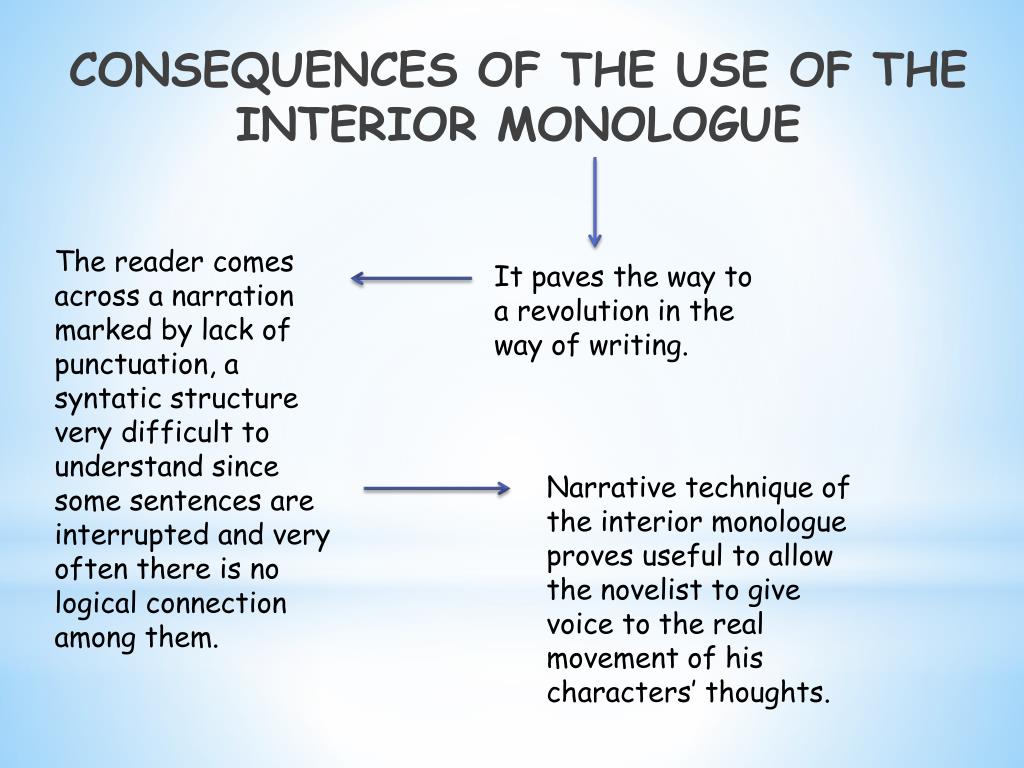


It’s also sometimes seen in mental health conditions, such as anxiety and depression.

While occasional self-criticism is to be expected from time to time, a consistently critical inner voice isn’t considered healthy.Ī critical inner voice may develop during times of extreme stress. If you’ve been told that you’re too hard on yourself, you may consider focusing on what your inner voice tells you.
#Interior monologue how to#
How to shift to a less-critical inner voice Such negative “self-talk” can influence your overall mood and self-esteem. Your inner voice may also have negative effects if you primarily experience self-criticism regularly. But some forms of internal monologue can be related to auditory hallucinations, when you may believe you’re hearing voices that aren’t actually there.Īuditory hallucinations are sometimes associated with certain mental health conditions such as schizophrenia as well as neurological conditions like Parkinson’s disease. Hearing your own inner voice isn’t itself harmful. You might ask yourself questions and work through the answers as a form of problem-solving. It may also help you organize your thoughts during times you can’t speak out loud. It’s particularly relevant to your auditory system in the way you process hearing speech.Īn inner monologue can help you hear your own voice while canceling other external stimuli. It helps you distinguish between different sensory experiences, such as those created internally or externally.Ĭorollary discharge helps explain why your own voice sounds one way when you speak out loud and why it may sound different on a recording or to other people.Įven if you don’t necessarily hear an inner voice, everyone experiences corollary discharge to some degree. Internal monologue is thought to be partially controlled by corollary discharge, a type of brain signal. The researchers highlight the need for larger studies to untangle the overlap between the two. If you find it difficult to picture voluntary images in your head at all, you may have what’s known as a phantasia.Ī 2021 study indicates that people with aphantasia may also experience anaduralia, a term that’s now being used to describe the absence of auditory imagery - or the inner voice.īased on survey responses from self-reported aphantasics, a lack of internal monologue may co-occur with aphantasia.

People with a hearing impairment may experience their inner monologue through signs or images. For example, you might “see” do-to lists in your head but not be able to “hear” yourself think. Not “hearing” your inner voice doesn’t necessarily mean you don’t have an internal monologue, though, because some people access it visually instead of auditorily. It’s unclear why some people don’t have an internal monologue, but researchers speculate it has to do with the way the dorsal stream matures, among other things. The emergence of inner speech is influenced by dorsal stream development. In childhood, the dorsal stream develops slower than the ventral stream. They’re also involved in auditory and visual processing. The dorsal and ventral streams are language tracts in the brain. One 2019 review of research suggests an association between dorsal pathway maturation and the emergence of inner speech in children. Researchers don’t fully understand why some people don’t have an inner voice. I would willingly give all my money that you should not disturb me but let me sit on and on, silent, alone," (Woolf 1931).What about people who don’t have an internal monologue? Do not come and worry me with your hints that it is time to shut the shop and be gone. Let me sit here forever with bare things, this coffee cup, this knife, this fork, things in themselves, myself being myself. How much better to sit by myself like the solitary sea-bird that opens its wings on the stake. "How much better is silence the coffee cup, the table.Not beautiful, not gay, but better than a tent on the beach," (Chandler 1942). "The same stuff I had had last year, and the year before that.
#Interior monologue full#
Three hard chairs and a swivel chair, flat desk with a glass top, five green filing cases, three of them full of nothing, a calendar and a framed license bond on the wall, a phone, a washbowl in a stained wood cupboard, a hatrack, a carpet that was just something on the floor, and two open windows with net curtains that puckered in and out like the lips of a toothless old man sleeping. I threw up another window, unlocked the communicating door and went into the room beyond. It was empty of everything but the smell of dust.


 0 kommentar(er)
0 kommentar(er)
